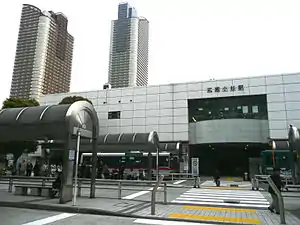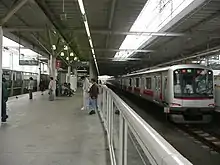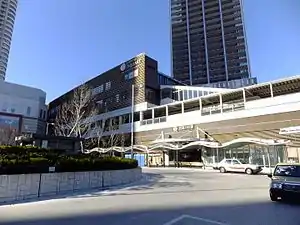Musashi-Kosugi Station
Musashi-Kosugi Station (武蔵小杉駅, Musashi-Kosugi-eki) are a pair of physically separated railway interchange stations, a block from each other, located in Nakahara Ward of eastern Kawasaki, Kanagawa, Japan, operated by East Japan Railway Company (JR East) and the private-sector railway operator Tokyu Corporation. Note that the term JR East Musashi-Kosugi Station is non-specific, the physical buildings of the Yokosuka and Nambu lines run by the same company are some 400 meters away, connected by a passageway.
Musashi-Kosugi Station 武蔵小杉駅 | |
|---|---|
 JR East Musashi-Kosugi Station, north exit | |
| Location | Nakahara, Kawasaki, Kanagawa Japan |
| Operated by | |
| History | |
| Opened | 1927 |
| Location | |
 Musashi-Kosugi Station Location within Japan | |
Area layout
There are essentially two complexes that make up Musashi-Kosugi Station, with a 400-meter connector passageway between them. The western complex contains a Nambu Line JR East station and a Tokyu station in one building. The eastern station is part of the Tokaido Line and contains JR East Yokosuka Line as well as Shinkansen tracks, though there is no stop. Although it is common to name stations after their operator, the term JR East Musashi-Kosugi Station is therefore non-specific as JR East services both complexes.
Lines
Musashi-Kosugi Station is served by JR East's Nambu Line, Yokosuka Line, and Shōnan-Shinjuku Line, as well as Tokyu's Tōyoko Line and Meguro Line.
JR East
MKGJN07JO15JS15 Musashi-Kosugi Station 武蔵小杉駅 | |
|---|---|
| JR East station | |
 JR Musashi-Kosugi Station exit | |
| Location | 3-492 Kosugimachi, Nakahara-ku, Kawasaki-shi, Kanagawa-ken (神奈川県川崎市中原区小杉町3-492) Japan |
| Operated by | |
| Line(s) |
|
| Connections | Bus terminal |
| History | |
| Opened | 1927 |
| Passengers | |
| FY2016 | 128,079 daily |
Station layout

JR Musashi-Kosugi Station has two opposed side platforms serving the two tracks (Platform 1 and Platform 2) of the Nambu Line and one island platform serving the two tracks (Platform 3 and Platform 4) of the Yokosuka Line. The Shōnan-Shinjuku Line and Narita Express share the Yokosuka Line platforms. The two sections of the JR station are located separately and connected by a 400 m long passage. All platforms are elevated, as is the station building.
Platforms
| 1 | JN Nambu Line | for Mukaigawara, Yakō, and Kawasaki |
| 2 | JN Nambu Line | for Musashi-Mizonokuchi, Noborito, and Tachikawa |
| 3 | JO Yokosuka Line | for Yokohama, Ōfuna, Zushi, and Kurihama |
| JS Shōnan-Shinjuku Line | for Yokohama, Zushi, and Odawara □ Super View Odoriko for Atami and Izukyū-Shimoda | |
| for Hazawa yokohama-kokudai Sotetsu Line for Nishiya and Futamatagawa | ||
| 4 | JO Yokosuka Line | for Tokyo, Chiba, and Narita Airport (Terminal 2·3 and Terminal 1) □ Narita Express for Narita Airport |
| JS Shōnan-Shinjuku Line | for Ōsaki, Shinjuku, Ikebukuro, Ōmiya, Takasaki and Utsunomiya □ Super View Odoriko for Shinjuku and Ikebukuro | |
| JA Through to Saikyō Line | for Ōsaki and Shinjuku |
Adjacent stations
| « | Service | » | ||
|---|---|---|---|---|
| Nambu Line JN07 | ||||
| Kashimada JN04 | Rapid | Musashi-Nakahara JN08 | ||
| Mukaigawara JN06 | Local | Musashi-Nakahara JN08 | ||
| Yokosuka Line JO15 | ||||
| Yokohama YHMJO13 |
Narita Express | Shinagawa SGWJO17 | ||
| Shin-Kawasaki JO14 | Local | Nishi-Ōi JO16 | ||
| Shōnan-Shinjuku Line JS15 | ||||
| Yokohama YHMJS13 |
Saphir Odoriko | Shibuya SBYJS19 | ||
| Yokohama YHMJS13 |
Special Rapid | Ōsaki OSKJS17 | ||
| Yokohama YHMJS13 |
Rapid | Ōsaki OSKJS17 | ||
| Shin-Kawasaki JS14 | Local | Nishi-Ōi JS16 | ||
| Hazawa yokohama-kokudai |
Sotetsu JR Link Line services | Nishi-Ōi JS16 | ||
Tokyu
TY11 MG11 Musashi-Kosugi Station 武蔵小杉駅 | |
|---|---|
| Tokyu station | |
 Tokyu Musashi-Kosugi main entrance | |
| Location | 3-472 Kosugimachi, Nakahara Ward, Kawasaki City, Kanagawa Prefecture Japan |
| Operated by | ■ Tokyu Corporation |
| Line(s) |
|
| Other information | |
| Station code | TY11, MG11 |
| History | |
| Opened | 1945 |
| Passengers | |
| FY2016 | 222,674 daily |
Station layout
Tokyu Musashi-Kosugi Station has two island platforms serving four tracks. The outer tracks (Platform 1 and Platform 4) are used by the Tokyu Toyoko Line, and the inner tracks (Platform 2 and Platform 3) are used by the Tokyu Meguro Line. All platforms are elevated, as is the station building.
Platforms
| 1 | ■ Tokyu Toyoko Line | for Kikuna, Yokohama, Minatomirai, Motomachi-Chūkagai |
| 2 | ■ Tokyu Meguro Line | for Hiyoshi |
| 3 | ■ Tokyu Meguro Line | for Ōokayama, Meguro, Akabane-Iwabuchi (Tokyo Metro Namboku Line), Urawa-Misono (Saitama Rapid Railway Line), Nishi-Takashimadaira (Toei Mita Line) |
| 4 | ■ Tokyu Toyoko Line | for Jiyūgaoka, Naka-Meguro, Shibuya, (Tokyo Metro Fukutoshin Line) |
Adjacent stations
| « | Service | » | ||
|---|---|---|---|---|
| Tokyu Toyoko Line TY11 | ||||
| Jiyūgaoka TY07 | Limited Express / F Liner | Kikuna TY16 | ||
| Jiyūgaoka TY07 | Commuter Express | Hiyoshi TY13 | ||
| Tamagawa TY09 | Express | Hiyoshi TY13 | ||
| Shin-Maruko TY10 | Local | Motosumiyoshi TY12 | ||
| Tokyu Meguro Line MG11 | ||||
| Hiyoshi MG13 | Express | Tamagawa MG09 | ||
| Motosumiyoshi MG12 | Local | Shin-Maruko MG10 | ||
History
The area around the station was served by the Nambu and Toyoko lines since the 1920s, but over an extended period of time it was integrated as Musashi-Kosugi Station in 1945. Since then, the station has functioned as a major transfer point for people residing in Kawasaki (along the Nambu Line) who commute to Tokyo.
Although the station was already a major station along the two lines in the 1990s, the station started further expansion of its role when the Meguro Line opened in 2000 with direct service to the Tokyo subway lines. The 2010 opening of the new platform for the Yokosuka Line and Shōnan-Shinjuku Line connected the station with many directions in Kantō region, including Narita Airport.
Musashi-Kosugi Station opened as Ground-mae Stop (グラウンド前停留場, Guraundomae-Teiryūjō) and as Musashi-Kosugi Stop (武蔵小杉停留場, Musashi-Kosugi-Teiryūjō) on the Nambu Railway on November 1, 1927. The nearby Kōgyōtoshi Station (工業都市駅, Kōgyōtoshi-eki) on the Toyoko Line opened on December 11, 1939. The Nambu Railway was nationalized on April 1, 1944, becoming part of into the Japanese Government Railway (JGR) system. Ground-mae Stop became Musashi-Kosugi Station, and the former Musashi-Kosugi Stop was abolished. After the end of World War II, JGR became the Japanese National Railways (JNR). On June 16, 1945, Musashi-Kosugi Station on the Toyoko Line opened, and on March 31, 1953 Kōgyōtoshi Station was abolished.
On November 27, 1988, Grade separation work removed the level crossings on Tachikawa-bound tracks, and by December 20, 1988, grade separation work removed the level crossings on Kawasaki-bound tracks. Along with privatization and division of JNR, JR East started operating the former JNR portion of the station on April 1, 1987. On August 6, 2000, the Tokyu Meguro Line opened; the line was extended to connect to the Tokyu Meguro Line on June 22, 2008. The station was further expanded on March 13, 2010, when Yokosuka Line and Shōnan-Shinjuku Line trains began stopping.
Station numbering was introduced on all Tokyu Railway lines during fiscal 2012, with Musashi-Kosugi Station becoming "TY11" for the Toyoko Line and "MG11" for the Meguro Line.[1]
Passenger statistics
In fiscal 2013, the JR East station was used by 115,262 passengers daily (boarding passengers only), making it the 27th-busiest station operated by JR East.[2] Passenger usage for the JR East station has almost doubled since fiscal 1999, when the station was the 61st-busiest JR East station with an average of 64,165 passengers daily.[3] In fiscal 2013, the Tokyu Toyoko Line station was used by an average of 160,939 passengers daily and the Meguro Line station was used by an average of 40,920 passengers daily.[4] The daily passenger figures for each operator in previous years are as shown below.
| Fiscal year | JR East | Tokyu | |
|---|---|---|---|
| Toyoko Line | Meguro Line | ||
| 1999 | 64,165[3] | ||
| 2000 | 64,336[5] | ||
| 2005 | 70,685[6] | 154,951[7] | 30,058[7] |
| 2010 | 99,617[8] | 152,910[9] | 39,102[9] |
| 2011 | 103,624[10] | 149,361[11] | 38,028[11] |
| 2012 | 108,046[12] | 150,325[13] | 39,006[13] |
| 2013 | 115,262[2] | 160,939[4] | 40,920[4] |
- Note that JR East figures are for boarding passengers only.
Surrounding area
The area had until the late 2000s been a rather nondescript 'endless' suburbia, broken up only by the Tama River. At that time, the locals called the area Musako. However, with skyscraper construction giving the area an urban feel and outsider influx, the new local nickname Kosugi has emerged.[14] The term Musashi refers to Nambu Line, the first train line through the area, which the line name itself is a reference to former Musashi Province, the southern rim which the line runs along.

- Nippon Medical School Musashi-kosugi Campus
- Nippon Medical University Musashi Kosugi Hospital
- Todoroki Ryokuchi athletic park
See also
References
- Harris, Ken and Clarke, Jackie. Jane's World Railways 2008-2009. Jane's Information Group (2008). ISBN 0-7106-2861-7
- 東急線全駅で駅ナンバリングを導入します [Station numbering to be introduced at all Tokyu stations] (PDF). News Release (in Japanese). Japan: Tokyū Corporation. January 26, 2012. Retrieved 7 September 2014.
- 各駅の乗車人員 (2013年度) [Station passenger figures (Fiscal 2013)] (in Japanese). Japan: East Japan Railway Company. Retrieved 7 September 2014.
- 各駅の乗車人員 (1999年度) [Station passenger figures (Fiscal 1999)] (in Japanese). Japan: East Japan Railway Company. Retrieved 7 September 2014.
- 2013年度乗降人員 [2013 Station passenger figures] (in Japanese). Japan: Tokyū Corporation. 4 June 2014. Retrieved 7 September 2014.
- 各駅の乗車人員 (2000年度) [Station passenger figures (Fiscal 2000)] (in Japanese). Japan: East Japan Railway Company. Retrieved 7 September 2014.
- 各駅の乗車人員 (2005年度) [Station passenger figures (Fiscal 2005)] (in Japanese). Japan: East Japan Railway Company. Retrieved 7 September 2014.
- 2005年度乗降人員 [2005 Station passenger figures] (in Japanese). Japan: Tokyū Corporation. 19 May 2006. Retrieved 7 September 2014.
- 各駅の乗車人員 (2010年度) [Station passenger figures (Fiscal 2010)] (in Japanese). Japan: East Japan Railway Company. Retrieved 7 September 2014.
- 2010年度乗降人員 [2010 Station passenger figures] (in Japanese). Japan: Tokyū Corporation. 19 May 2011. Retrieved 7 September 2014.
- 各駅の乗車人員 (2011年度) [Station passenger figures (Fiscal 2011)] (in Japanese). Japan: East Japan Railway Company. Retrieved 7 September 2014.
- 2011年度乗降人員 [2011 Station passenger figures] (in Japanese). Japan: Tokyū Corporation. 15 May 2012. Retrieved 7 September 2014.
- 各駅の乗車人員 (2012年度) [Station passenger figures (Fiscal 2012)] (in Japanese). Japan: East Japan Railway Company. Retrieved 7 September 2014.
- 2012年度乗降人員 [2012 Station passenger figures] (in Japanese). Japan: Tokyū Corporation. 29 May 2013. Retrieved 7 September 2014.
- "『【散歩】たみとのぶらり散歩「新丸子」 Vol.8 昔住んだ街!』".
External links
| Wikimedia Commons has media related to Musashi-Kosugi Station. |
- Musashi-Kosugi Station (JR East) (in Japanese)
- Musashi-Kosugi Station (Tokyu) (in Japanese)